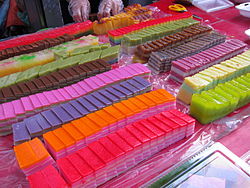Southeast Asian snack or dessert foods From Wikipedia, the free encyclopedia
Kuih (Jawi: کوءيه; Indonesian: kue; derived from the Hokkien and Teochew kueh – 粿) are bite-sized snack or dessert foods commonly found in Southeast Asia, Taiwan and China. It is a fairly broad term which may include items that would be called cakes, cookies, dumplings, pudding, biscuits, or pastries in English and are usually made from rice or glutinous rice.[1] In China, where the term originates from, kueh or koé (粿) in the Min Nan languages (known as guǒ in Mandarin) refers to snacks which are typically made from rice but can occasionally be made from other grains such as wheat. The term kuih is widely used in Malaysia, Brunei, and Singapore, kueh is used in Singapore and Indonesia, kue is used in Indonesia only,[1] all three refer to sweet or savoury desserts.
This article needs additional citations for verification. (February 2020) |
 Colourful kuih | |
| Alternative names | Kue (Indonesia), Kueh (Singapore, Hokkien and Teochew) |
|---|---|
| Course | Snack |
| Region or state | Southeast Asia and China |
| Associated cuisine | Brunei, China, Malaysia, Singapore, Taiwan, Indonesia (Kue) |
| Main ingredients | Various traditional snacks |
| Similar dishes | Mont, Khanom, Bánh, Kakanin |
Similar snacks are found throughout Southeast Asia, including the Burmese mont, Filipino kakanin, Thai khanom and Vietnamese bánh. For example, the colourful steamed kue lapis and the rich kuih bingka ubi are also available in Myanmar, Thailand, and Vietnam.
Kuihs are not confined to a certain meal but can be eaten throughout the day. They are an integral part of Malaysian, Indonesian, Bruneian and Singaporean festivities such as Hari Raya and Chinese New Year. Many kuih are sweet, but some are savoury.[2] In the northern states of Perlis, Kedah, Perak, and Kelantan, kuih (kuih-muih in Malay) are usually sweet. In the Southeast Peninsular states of Negeri Sembilan, Melaka and Selangor, savoury kuih can be found. Kuih are more often steamed than baked, and are thus very different in texture, flavour and appearance from Western cakes or puff pastries.
In almost all Malay kuih, the most common flavouring ingredients are grated coconut (plain or flavoured), coconut cream (thick or thin), pandan (screwpine) leaves and gula melaka (palm sugar, fresh or aged). While those make the flavour of kuih, their base and texture are built on a group of starches: rice flour, glutinous rice flour, glutinous rice and tapioca. Two other common ingredients are tapioca flour and green bean (mung bean) flour (sometimes called "green pea flour" in certain recipes). They play the most important part in giving kuihs their distinctive soft, almost pudding-like, yet firm texture. Wheat flour is rarely used in Southeast Asian cakes and pastries.
For most kuih, there is no single "original" or "authentic" recipe. Traditionally, making kuih was the domain of elderly grandmothers, aunts and other womenfolk, for whom the only (and best) method for cooking was by "agak-agak" (approximation). They would take handfuls of ingredients and mix them without any measurements or any need of weighing scales. The end product is judged by its look and feel, the consistency of the batter and how it feels to the touch. Each family holds its own traditional recipe as well as each region and state.

Nyonya (Peranakan) kuih are sometimes represented as distinct from Malay and Indonesian kuih, but many Nyonya kuih are fundamentally the same as Malay or Indonesian kuih. For some Nyonya kuih, there are minor changes to Malay kuih to suit Peranakan eating habits and tastes.[3]

Seamless Wikipedia browsing. On steroids.